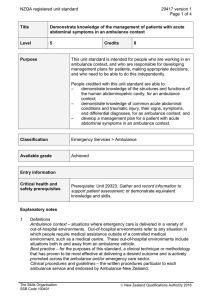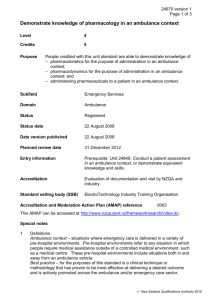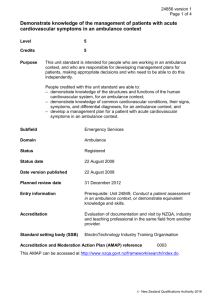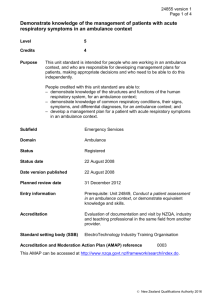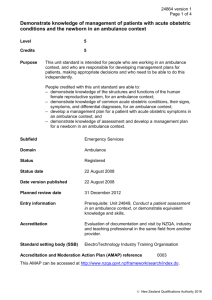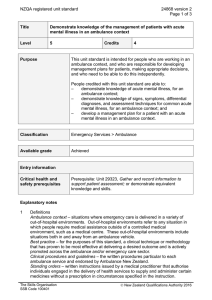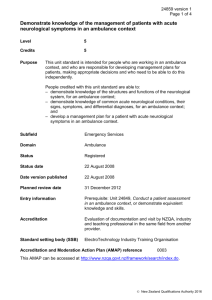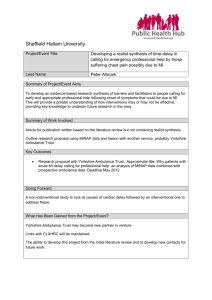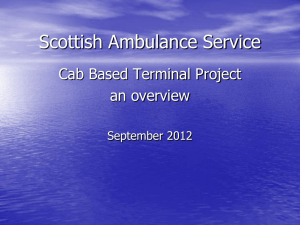24857 Demonstrate knowledge of the management of patients with
advertisement
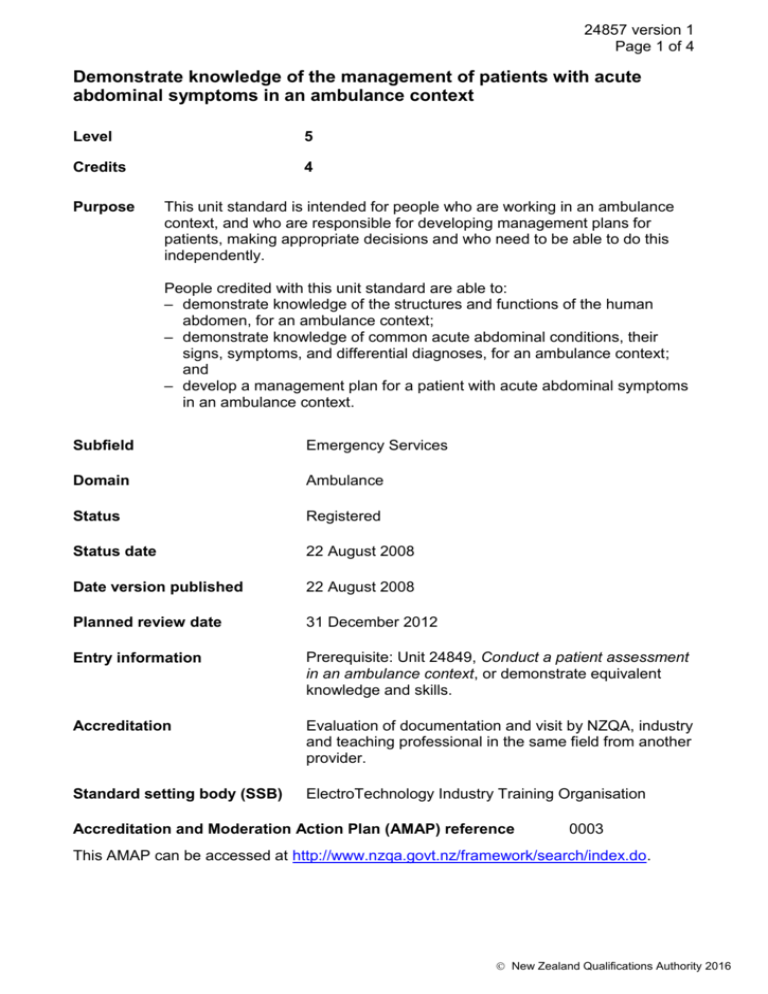
24857 version 1 Page 1 of 4 Demonstrate knowledge of the management of patients with acute abdominal symptoms in an ambulance context Level 5 Credits 4 Purpose This unit standard is intended for people who are working in an ambulance context, and who are responsible for developing management plans for patients, making appropriate decisions and who need to be able to do this independently. People credited with this unit standard are able to: – demonstrate knowledge of the structures and functions of the human abdomen, for an ambulance context; – demonstrate knowledge of common acute abdominal conditions, their signs, symptoms, and differential diagnoses, for an ambulance context; and – develop a management plan for a patient with acute abdominal symptoms in an ambulance context. Subfield Emergency Services Domain Ambulance Status Registered Status date 22 August 2008 Date version published 22 August 2008 Planned review date 31 December 2012 Entry information Prerequisite: Unit 24849, Conduct a patient assessment in an ambulance context, or demonstrate equivalent knowledge and skills. Accreditation Evaluation of documentation and visit by NZQA, industry and teaching professional in the same field from another provider. Standard setting body (SSB) ElectroTechnology Industry Training Organisation Accreditation and Moderation Action Plan (AMAP) reference 0003 This AMAP can be accessed at http://www.nzqa.govt.nz/framework/search/index.do. New Zealand Qualifications Authority 2016 24857 version 1 Page 2 of 4 Special notes 1 Definitions Ambulance context – situations where emergency care is delivered in a variety of pre-hospital environments. Pre-hospital environments refer to any situation in which people require medical assistance outside of a controlled medical environment, such as a medical centre. These pre-hospital environments include situations both in and away from an ambulance vehicle. Best practice – for the purposes of this standard is a clinical technique or methodology that has proven to be most effective at delivering a desired outcome and is actively promoted across the ambulance and/or emergency care sector. Clinical procedures – the written procedures particular to each ambulance service and endorsed by Ambulance New Zealand. Standing orders – written instructions issued by a medical practitioner that authorise individuals engaged in the delivery of health services to supply and administer certain medicines without a prescription in circumstances specified in the instruction. 2 References Health and Disability Commissioner (Code of Health and Disability Services Consumers’ Rights) Regulations 1996; and all subsequent amendments and replacements. 3 Range Performance in relation to the elements in this unit standard is to comply with current clinical procedures and/or standing orders and/or current best practice and be appropriate to the patient’s condition. Elements and performance criteria Element 1 Demonstrate knowledge of the structures and functions of the human abdomen, for an ambulance context. Performance criteria 1.1 The location and structure of the parts of the human abdomen are described according to their functions. Range 1.2 includes but is not limited to – aorta, appendix, bowel, pancreas, liver, spleen, kidneys, gall bladder, urinary bladder, stomach. Functions of the digestive system are described according to physiological processes. Range may include but is not limited to – digestion, waste removal. New Zealand Qualifications Authority 2016 24857 version 1 Page 3 of 4 Element 2 Demonstrate knowledge of common acute abdominal conditions, their signs, symptoms, and differential diagnoses, for an ambulance context. Performance criteria 2.1 Common acute abdominal conditions are described according to their pathophysiology. Range includes but is not limited to – appendicitis, abdominal aortic aneurysm (AAA), bowel obstruction, gastroenteritis, gastrointestinal bleeding, renal or biliary stones. 2.2 Signs and symptoms of common acute abdominal problems are described. 2.3 Differential diagnoses for common acute abdominal symptoms are described. 2.4 Differential diagnoses for non-abdominal conditions are described. Element 3 Develop a management plan for a patient with acute abdominal symptoms in an ambulance context. Performance criteria 3.1 The general management steps for patients with acute abdominal symptoms are described. 3.2 Specific therapies used in the management of patients with acute abdominal symptoms are described. Range 3.3 includes but is not limited to – oxygen, pain relief. A management plan for a patient with acute abdominal symptoms is developed, explained, and justified Please note Providers must be accredited by NZQA, or an inter-institutional body with delegated authority for quality assurance, before they can report credits from assessment against unit standards or deliver courses of study leading to that assessment. Industry Training Organisations must be accredited by NZQA before they can register credits from assessment against unit standards. Accredited providers and Industry Training Organisations assessing against unit standards must engage with the moderation system that applies to those standards. New Zealand Qualifications Authority 2016 24857 version 1 Page 4 of 4 Accreditation requirements and an outline of the moderation system that applies to this standard are outlined in the Accreditation and Moderation Action Plan (AMAP). The AMAP also includes useful information about special requirements for organisations wishing to develop education and training programmes, such as minimum qualifications for tutors and assessors, and special resource requirements. Comments on this unit standard Please contact the ElectroTechnology Industry Training Organisation reviewcomments@etito.co.nz if you wish to suggest changes to the content of this unit standard. New Zealand Qualifications Authority 2016
